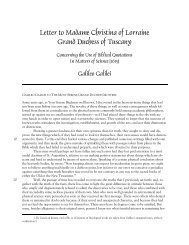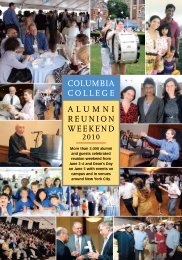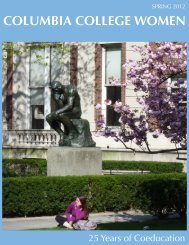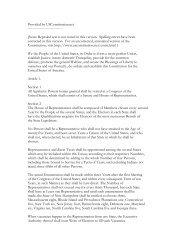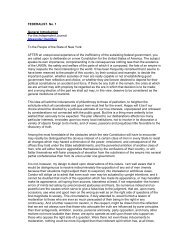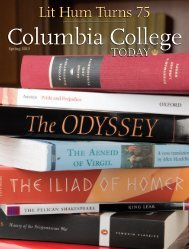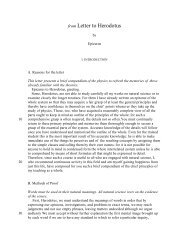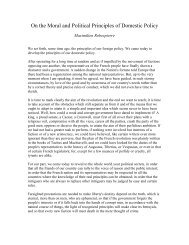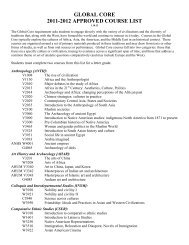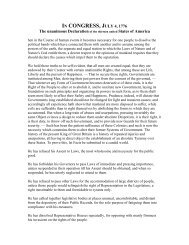Download this issue as a PDF - Columbia College - Columbia ...
Download this issue as a PDF - Columbia College - Columbia ...
Download this issue as a PDF - Columbia College - Columbia ...
Create successful ePaper yourself
Turn your PDF publications into a flip-book with our unique Google optimized e-Paper software.
COLUMBIA COLLEGE TODAY<br />
This article w<strong>as</strong> first published in June for “Still Life,” a series of New<br />
York Times articles in which Times writers sketched their favorite<br />
summer images.<br />
The heat comes quickly in the summer. By early June,<br />
working at home with no air-conditioning, I have no<br />
concentration. Everything feels close and impolite<br />
and loud.<br />
So I go to Butler Library, on the southern end of<br />
<strong>Columbia</strong>’s campus in Morningside Heights. What began <strong>as</strong> a diversion<br />
h<strong>as</strong> become a self-preserving summer thing: not just Butler,<br />
but the Butler stacks, the stillness capital of my imagination.<br />
My job <strong>as</strong> a music critic depends on listening in crowds and<br />
writing in solitude. It also involves gathering facts and context,<br />
Ben Ratliff ’90 finds sanctuary inside the stacks at Butler Library.<br />
PHOTO: DANIEL PORTALATIN PHOTOGRAPHY<br />
of which there is exponentially more every day. I think by writing,<br />
and I write on a computer; the computer also contains the<br />
Internet, which manufactures express-service context <strong>as</strong> well <strong>as</strong><br />
overstatement, sociopathy and lameness. In my hot office I w<strong>as</strong><br />
starting to look at it abstractly, <strong>as</strong> a hot thing blowing exhaust.<br />
I needed to renegotiate my relationship with space and sound<br />
and information.<br />
Butler is a 1930s neo-Cl<strong>as</strong>sical hulk. At the front, above 14 columns,<br />
runs a list of writers and thinkers; the l<strong>as</strong>t is Vergil, and I<br />
like that someone long ago took a stand and chose to spell it in<br />
the Anglicization closer to his real name, not the more common<br />
“Virgil.” It announces: nonsense not spoken here.<br />
In the late ’80s, I’d been there a lot, studying and working <strong>as</strong> a<br />
A l u m n i C o r n e r<br />
Butler Stacks Offer a World Apart<br />
B y Ben Rat l i f f ’90<br />
summer employee. When I turned up at the Library Information<br />
office l<strong>as</strong>t year, there w<strong>as</strong> much clucking about how I’d graduated<br />
so very long ago that they needed a whole other datab<strong>as</strong>e<br />
to find my information. But that’s cool: I am from another time.<br />
Pre-air-conditioning.<br />
I had come to work but also to tune myself up. So I split the<br />
day. Some for my bosses, some for me. After I met my deadline,<br />
writing in the reference room, I walked behind the main desk into<br />
the stacks. The <strong>Columbia</strong> library system owns over 10 million<br />
volumes; 1.5 million, humanities and history, live here. I moved<br />
around for a few hours in the stillness, looking things up, standing<br />
up or crouching the whole time, purely and almost dopily happy.<br />
I’d forgotten. The Butler stacks are in a different sensory category,<br />
starting from the threshold: If you’re tall, you bow your<br />
head <strong>as</strong> you p<strong>as</strong>s through the low door<br />
frame. They form an enclosed rectangular<br />
prism at the center of Butler — no<br />
windows, a bit cooler than the rest of the<br />
building. Two or three levels of the inner<br />
stacks can correspond to one floor of the<br />
outer library. All <strong>this</strong> reinforces the feeling<br />
that the stacks are something special:<br />
a separate province or a vital inner organ.<br />
Inside there is the deep quiet of protection<br />
and near-abandonment. You hear the<br />
hum of the lights, turned on <strong>as</strong> needed;<br />
that’s it. There’s a phone to make outgoing<br />
calls on the fifth floor. To me the stacks<br />
are the most sacred space in the library,<br />
yet here nobody’s telling you not to talk.<br />
You’re on your own. It’s a situation for<br />
adults.<br />
Unlike the stacks at some other university<br />
libraries, Butler’s were not built<br />
for public consumption. They opened to<br />
patrons gradually, much later; originally,<br />
Butler had a call desk, where you’d<br />
put in your requests and wait for your<br />
numbers to come up.<br />
“That’s why they’re not pretty stacks,” said Karen Green, Butler’s<br />
librarian for ancient and medieval history and for religion and<br />
graphic novels. She said it with empathy. Both she and I know that<br />
they are very beautiful.<br />
I spent a few weeks there in the worst of l<strong>as</strong>t June and July,<br />
grazing around, letting the shelves make the connections for me,<br />
writing down notes for a book whose thesis grew obscure and finally<br />
implausible: I w<strong>as</strong> looking up works on plague, fire and the<br />
Egyptian desert fathers. I learned well, but I felt even better. I took<br />
in great amounts of information without ever becoming fried or<br />
irritable. All that organization and nobody around — it seemed<br />
like tresp<strong>as</strong>sing in the history of Western learning, with no fear of<br />
(Continued on page 103)<br />
So You Think You Know<br />
Your Former Deans?<br />
With the recent naming of James J. Valentini <strong>as</strong> Dean of the <strong>College</strong>,<br />
we thought <strong>this</strong> would be an opportune time to test your<br />
familiarity with some of the people who have held that office.<br />
1. Which Dean of the <strong>College</strong> (hint: he w<strong>as</strong> a mathematician) served<br />
longer than any other?<br />
2. How many deans h<strong>as</strong> <strong>Columbia</strong> <strong>College</strong> had?<br />
3. Which dean, who once described himself <strong>as</strong> “a good dirt farmer<br />
who never should have left Saratoga County,” is the only one to<br />
have a campus building named after him?<br />
4. Which dean, who now teaches <strong>as</strong> the Brander Matthews Professor<br />
of Dramatic Literature, h<strong>as</strong> a campus theatre named after him?<br />
5. Who w<strong>as</strong> the first Dean of the <strong>College</strong>?<br />
6. True or False: A majority of the <strong>College</strong>’s deans graduated from<br />
<strong>Columbia</strong> <strong>College</strong>.<br />
7. What is the street address of Hamilton Hall, where the Office of<br />
the Dean is located?<br />
8. What dean argued Brown v. Board of Education, the c<strong>as</strong>e that<br />
declared “separate but equal” unconstitutional, before the Supreme<br />
Court in 1954, and co-authored the cookbook Dean Cuisine?<br />
9. Which dean, who later became president of Mount Holyoke<br />
<strong>College</strong>, recounted the “nightmarish experience of witnessing,<br />
of experiencing, what can properly be described <strong>as</strong> the<br />
disintegration of a great university” in his book Reflections<br />
on the <strong>Columbia</strong> Disorders of 1968?<br />
10. Which dean became president of Amherst <strong>College</strong> and authored<br />
the novel Rules for Old Men Waiting, which won the McKitterick<br />
Prize in 2006?<br />
Bonus: Which dean is the founder and director of the Center for the<br />
Study of Science and Religion at <strong>Columbia</strong>?<br />
PHOTO: DANIELLA ZALCMAN ’09<br />
Answers on page 103.<br />
FALL 2012<br />
104




